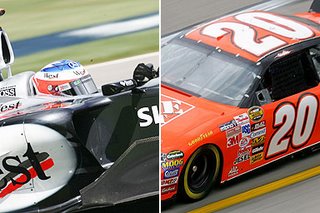In Road Racing You Turn Both Ways

Yesterday was a day of contrast in terms of racing on television. You had two of the most popular racing series in the world going head to head at nearly the same time of day on opposite ends of the North American continent. You had the pinnacle of motor racing, Formula One, running the Canadian Grand Prix in Montreal; and you had the best drivers in the world racing in Sonoma, California in the Dodge/Save-Mart 350 at the Infineon Raceway. Some of you out there must be wondering what the big deal is with having two races running on the same day. After all, it happens nearly every other week.
What set this weekend apart was the fact that this week, NASCAR drivers would be racing on a road course that was a big departure from their typical ovals and superspeedways. Talk to any fan of motor racing and they will have at least a dozen NASCAR jokes ready to be sprung at the drop of a flag... er... hat. For example, if you're being chased by a crazed NASCAR fan how do you escape? Turn right. NASCAR touts itself as having the best drivers in the world. Now I will grant you that the drivers who drive in the various series' in NASCAR are indeed among the best drivers in the world. It takes skill, conditioning and endurance to drive several tons of speeding metal around a track for several hours.
But let's look at the drivers who were on the opposite coast for a moment. Formula One racing is considered the absolute edge of your seat in terms of racing technology. The cars themselves are such precisely constructed works of art that even the slightest miscalculation can lead to a loss in speed and power. Some might argue that with all this technology, the driver is not even a requirement. Not so. Were a driver not needed in Formula One, it's quite likely that even the perennial backmarkers would be actual contenders. Here also drivers are tested for their skills.
So how can you compare the two? Simple, look at them both when they are racing under similar conditions. This weekend was unique for that very reason. Formula One always races on a road course with twists and turns ane elevation changes. NASCAR had their go on a road course with mixed results. The race wasn't even one lap old when the first red flag of the day was flown due to a pretty messy shunt (i.e. crash) at the start of the race. Now again, I grant you that driving a Formula One car and driving a stock car are like trying to compare a Boxster to a Cayenne. Sure in essence they are the same, but there are differences that mean you can't drive one like the other.
However, given the limitations of both, the basic principle and guiding force (literally) should still apply equally and that is the driver! My dad has an SUV which isn't like my Boxster. I have to adapt my driving style when I drive the SUV. If I try to take a corner the same way I would in my Boxster then you're definitely asking to end up flipped over in a ditch. Similarly, an all-round driver, or the 'best drivers in the world' should have no problem adapting to turning a car in another direction; yet when the time came to do just that we had accidents all over the place. Is this what we can expect from the best drivers in the world? Again, there are so many things that can be brought up to justify the difficulty for NASCAR drivers, the number of cars on the grid, the weight differences, the skills needed, all that; they are valid points too, but still, if you can't turn your car to the right without getting into the marbles and dirt, are you truly among the best drivers in the world?
Labels: Sports

0 Comments:
Post a Comment
<< Home